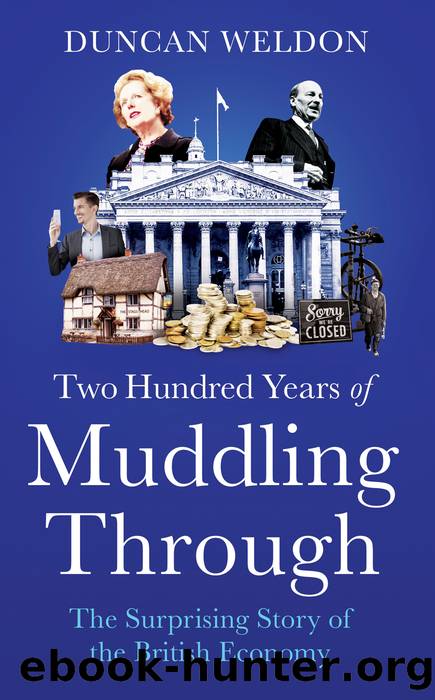Two Hundred Years of Muddling Through by Duncan Weldon

Author:Duncan Weldon
Language: eng
Format: epub
Publisher: Little, Brown Book Group
Published: 2021-08-26T00:00:00+00:00
12
Never Had It So Good
Given the lasting impact of the Attlee government, the fact that it lasted only six years is somewhat perplexing. By 1951, though, the government was already looking tired. The key ministers had been in office not since 1945 but since 1940. Waging a total war and then fundamentally reshaping Britainâs political economy over the course of a decade was presumably rather taxing work. The introduction of some NHS charging provoked Cabinet resignations (including that of Nye Bevan, the minister who had presided over the NHSâs birth) and left the government looking not just listless but also divided. In the long run the expansion of welfare payments, the provision of free healthcare, the material increase in education funding and the commitment to full employment would offer a great deal to many British voters, but in the short term life under the latter half of the Attlee government did not necessarily appear great.
The devaluation of 1949 was not only a blow to prestige but materially raised the cost of imported goods. Cigarette prices rose by 14 per cent, which is the kind of thing a nation of smokers tends to notice. That, combined with continued rationing and restrictions, not to mention a higher tax burden, left workers feeling somewhat squeezed. The prioritising of exports and public services over investment not only crimped business investment but also house building. Offered a choice between the larger state of the Attlee government and a return to the pre-war norm, it is almost certain that the British people would have stuck with Labour in the 1950s. But that was not the choice that was before them. The Conservative Party that was re-elected in 1951 had once again re-invented itself. Churchill might still be leader, but his domestic agenda was more in keeping with the New Liberal reformist spirit of his youth than his spell as a tight-money Chancellor overseeing the return to gold in the 1920s. Fundamentally the Conservative electoral proposition in 1951 amounted to âYou can keep all the stuff you like, but weâll also roll back restrictions on personal spending and build more houses.â That proved a popular offer, one that would keep the Conservatives in power until the mid-1960s. Such was the perceived continuity with Labour, in terms of the overall economic approach, that the term âButskellismâ (named for Labourâs last Chancellor, Hugh Gaitskell, and his Tory successor Rab Butler) has come to be used to describe the broad macro policies of 1945 to 1979. Butskellism was never as coherent or as unchallenged as is sometimes believed. But there was certainly a great deal of economic continuity over the three or so decades following the Second World War.
In 1957, Harold Macmillan, the Conservative Prime Minister, proclaimed in Bedford: âGo around the country, go to the industrial towns, go to the farms and you will see a state of prosperity such as we have never seen in my lifetime.â As he famously put it, âmost of our people have never had it so goodâ.
Download
This site does not store any files on its server. We only index and link to content provided by other sites. Please contact the content providers to delete copyright contents if any and email us, we'll remove relevant links or contents immediately.
International Integration of the Brazilian Economy by Elias C. Grivoyannis(90705)
The Radium Girls by Kate Moore(11921)
Turbulence by E. J. Noyes(7935)
Nudge - Improving Decisions about Health, Wealth, and Happiness by Thaler Sunstein(7615)
The Black Swan by Nassim Nicholas Taleb(7010)
Rich Dad Poor Dad by Robert T. Kiyosaki(6399)
Pioneering Portfolio Management by David F. Swensen(6226)
Man-made Catastrophes and Risk Information Concealment by Dmitry Chernov & Didier Sornette(5921)
Zero to One by Peter Thiel(5684)
Secrecy World by Jake Bernstein(4641)
Millionaire: The Philanderer, Gambler, and Duelist Who Invented Modern Finance by Janet Gleeson(4374)
The Age of Surveillance Capitalism by Shoshana Zuboff(4209)
Skin in the Game by Nassim Nicholas Taleb(4161)
Bullshit Jobs by David Graeber(4094)
The Money Culture by Michael Lewis(4074)
Skin in the Game: Hidden Asymmetries in Daily Life by Nassim Nicholas Taleb(3929)
The Dhandho Investor by Mohnish Pabrai(3698)
The Wisdom of Finance by Mihir Desai(3650)
Blockchain Basics by Daniel Drescher(3495)
